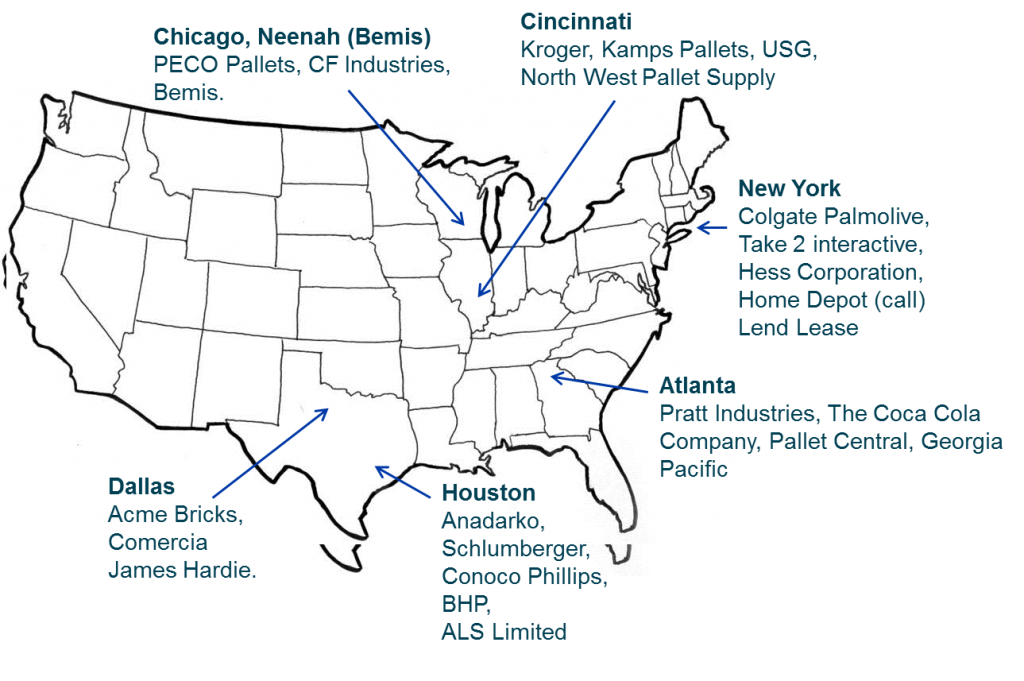USA Research Trip: 2017
Last month I travelled to the US on a company research trip. It was a timely and interesting excursion. Broadly, economic conditions in the US were better than I was expecting and the majority of management teams were upbeat. As the Pratt Industries CEO said “there appear no dark clouds in the horizon”. Notwithstanding the political stalemate and ineffectiveness of the current republican administration, the labour market appears tight, housing market has a tail wind and changing industry dynamics around consumer preferences are challenging traditional business models, and creating new opportunities for the companies that can adapt to the changing landscape.
In summary, three key takeaways from the trip:
- The US is at the forefront of changing landscape of retail consumer preferences. Large consumer brand companies appear to be struggling to adapt to lower revenue growth and changing industry structure as consumers move online.
- The US labour market is tight, especially at the lower end. This should result in meaningful wage inflation if it is sustained. However, this is being contained by large cost out from middle management across a number of consumer facing companies.
- The oil market is interestingly poised. From the companies we spoke to, it appears demand growth is helping absorb the supply. Management we met appear quite confident that US$50 dollars is the new base and companies are planning new investments in the sector.
Implications for the WaveStone portfolios
Given the offshore exposure for a number of companies in the portfolio, the confirmation around health of the US economy has helped conviction levels in companies that rely on a healthy housing market and bottom up demand for products and services.
On the contrary, companies exposed to the consumer sector will undoubtedly face ongoing headwinds which will continue to play out in the form of reduced profitability and lower margins and consumer preferences change. We have decided to sell our position in Brambles after the trip. We will also be discussing with Woolworths management their approach to this changing industry dynamic in the retail sector with the likely entry of Amazon.
The portfolios have a reasonable exposure to the Oil sector, with positions in Oil Search, Woodside and BHP, all of which we have a level of comfort they can continue to generate strong returns and free cash flow.
Companies visited

The following will outline further detail and observations from the trip.
Changing industry dynamic led by consumer preferences
Amazon is impacting the here and now in the US. This is different to Australia where the infiltration of online shopping (especially in groceries) has been considerably more measured. We met with Kroger, which is one of the world’s biggest supermarket retailers. It currently has approximately 2,800 stores in 35 states with annual sales of more than US$115.3 billion.
Kroger in recent times has spent time and capital focussed on their online offering. Key to that strategy has been the loyalty program and the success in maintaining loyalty through the sale of key items. They are focused on personalisation – using key data analytics. 25 million customers use loyalty cards, of which 90% of their sales go through this card. What was more surprising was 30% of the loyalty customer base account for 60-70pc of sales. Of the 90%, 60% are loyal. Their goal is to convert the high end of the non-loyal customer base.
Click and collect is offered in around 800 stores. They plan to extend this to over 1,000 stores. For this service they charge an extra US$5. Click and collect shopping is mainly concentrated on pantry items and dry groceries – less fresh food. In addition, they offer delivery in 150 stores using Uber and grocery runners. There is a US$12 charge on delivery. There are no plans for dark stores, omni-channel appears the best strategy.

Source: Houstonchronicle.com
The effect of the change in consumer preference to move online is being noticeably felt by larger consumer brand companies (P&G, Colgate and Coca Cola). They are struggling to grow their top line and there is no sign of a change in the immediate term as consumers move away to smaller boutique brands. In addition to this there is a clear de-stocking event occurring in the supermarkets due to the online presence getting larger (eg traditional promotions in the store such as “buy one get one free” do not work as well online). The discerning shopper on line is being targeted specifically with sale promotion activity and not likely to buy additional items on impulse.
The key takeaway from the meetings were Australian retailers need to further adapt.
Woolworths has the scale to be highly successful and get the logistics/last mile piece right to deliver growth, potentially at the expense of traditional bricks and mortar store roll outs. The company needs to strategically use its loyalty program to offer subscription based services to retain customers. It will be the speed of how they can transition which will determine their ultimate success.
Wages of lower skilled workers are finally going up
The US economy is performing well. From the management teams we spoke to there is a reasonable amount of confidence. For companies that hire manual workforce, the labour markets remain extremely tight. This explains the decent wage inflation (minimum wage implementation across some states has certainly helped). Management firmly believe it has been a lack of available manual labour that has held back the US recovery post the GFC. The period since Trump’s election has further exasperated the situation.
However certain parts of the economy, namely retailers and consumer brand companies are responding to pricing and volume pressure by cutting costs relatively aggressively. Costs are being taken from middle management, which are generally more expensive and experienced workers.
The key America consumer with arguably higher disposable income appears under pressure. The productivity improvements and the workers with traditionally higher disposable income are spending less. This may explain why the US wage inflation has stalled despite the tight labour market and wage inflation at the low end.
The oil market is interestingly poised
From the meetings with oil companies in Houston/New York, it appears demand growth especially in China, US and India is helping absorb the extra supply. The Global oil industry needs to spend around US$600bn capex a year to keep markets balanced. The falling oil price in 2015 led to oil companies forced to slash capital expenditure (capex) amid a prolonged price slump, with spending in North America bearing the brunt of the cuts. Hess Corporation, a global independent oil and gas explorer and producer, forecast US$380bn in global capex was spent in in 2016.This is forecast to be US$400bn in 2017 and around US$380bn in 2018. This is likely to lead to accelerated field decline in 2019-2020, resulting in an expected 3mn barrels of oil per day (bopd) decline per annum. Demand is expected to grow at 1.5mn bopd in 2017 and similar in 2018, further absorbing the excess supply. In addition to the lower capex, the Organisation of the Petroleum Exporting Countries (OPEC) cuts are drawing down inventories. Non-OPEC operating companies will start seeing field depletions and need to start reinvesting again.
This demand is balanced somewhat by the growth in supply in the US onshore which is still experiencing growth in production. The heightened focus on capital returns in the US shale industry and Rig activity appears to have plateaued. In the short term, there is an acute shortage of fracking crews which is hampering well completion and hence production growth. Productivity will still improve but there was unlikely to be a further large production surge. Generally management were quite confident that US$50 dollars is the new base and the majors were looking at reworking stalled projects from a few years ago.
Author: Raaz Bhuyan, Principal and Portfolio Manager

